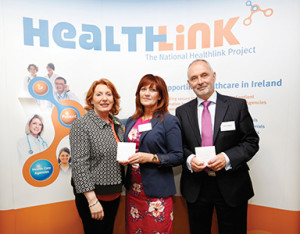The National Healthlink Project
 An overview of how the HSE project’s work streamlines administration for general practitioners and other significant healthcare providers.
An overview of how the HSE project’s work streamlines administration for general practitioners and other significant healthcare providers.
Technology has a central role in achieving increased efficiencies in delivering healthcare.
The National Healthlink Project has a proven track record in delivering IT solutions to GPs and hospitals and is the natural means by which the HSE chose to extend its communications with GPs when introducing new IT systems.
Healthlink has been the cornerstone for many of the HSE ICT initiatives over recent years. In 2014, Healthlink was involved in enabling the transfer of electronic correspondence to and from GPs for the National Electronic General Referral Pilot, the National Integrated Medical Imaging System (NIMIS) project, the National Cancer Control Programme (NCCP) initiatives and the National Screening Service. Healthlink are also involved in the planning stages with the National Medical Laboratory Information System project and the National Maternity and Newborn System.
Technology has an impact on general practice as it does in all other areas of healthcare. Healthlink services bring significant benefits and efficiencies to the day-to-day work of GPs, creating a noticeable difference to administration as well as significantly improving communication with local hospitals. Over the years the range of messages sent to GPs has been expanded, though laboratory, radiology and discharge summary reports remain the most popular. Healthlink also send death notifications, OPD appointment updates, waiting list updates, A&E attendance notifications, outpatient clinic letters, inpatient admissions and out of hours co-op messages.
Healthlink has a key role in the National Electronic General Referral project which enables GPs to refer patients for general outpatient hospital appointments. The system improves the overall patient experience by providing quicker access to outpatient appointments plus reduced duplication and delays as electronic referrals are transmitted to the hospital faster and safer. There are also benefits for GPs using the system – a centralised referral department to send all electronic appointments, an integrated form that auto-populates patient data plus an immediate acknowledgement of the referral. The system has been designed and developed in such a way that it can be rolled out nationally to all GPs and acute hospitals, beginning in Q2 2015.
Healthlink’s work on the General Referral Project mirrored that of the NCCP Electronic Cancer Referral Project. The development of electronic referrals for breast, lung, prostate and most recently, pigmented lesion cancer has been a huge success. Healthlink has delivered over 50,000 cancer referrals since 2009. Currently nearly 40 per cent of all breast, prostate and lung cancer referrals are sent electronically.
The National Healthlink Project initially commenced with the Mater Hospital in 1995. It has developed considerably since that time and now works with 61 hospitals and clinical centres around the country. There are 3,400 GPs and 1,402 practices currently using the service. Over 50 million messages have been delivered by Healthlink since commencement and, most significantly, a record 10 million in 2014. The 10 millionth message was a laboratory report sent from St James’s Hospital to Dr Miriam Carey, The Iveagh Medical Clinic, Crumlin, Dublin 12.
The National Healthlink Project is funded by the HSE and all services are free of charge to general practitioners. Healthlink also now work with private hospitals and clinics; costs are involved for those organisations which operate in the private healthcare sector.
For more information contact:
Gemma Garvan
National Healthlink Project
58 Eccles Street
Dublin 7
Tel: 01 882 5606
Email: garvang@healthlink.ie
Web: www.healthlink.ie





